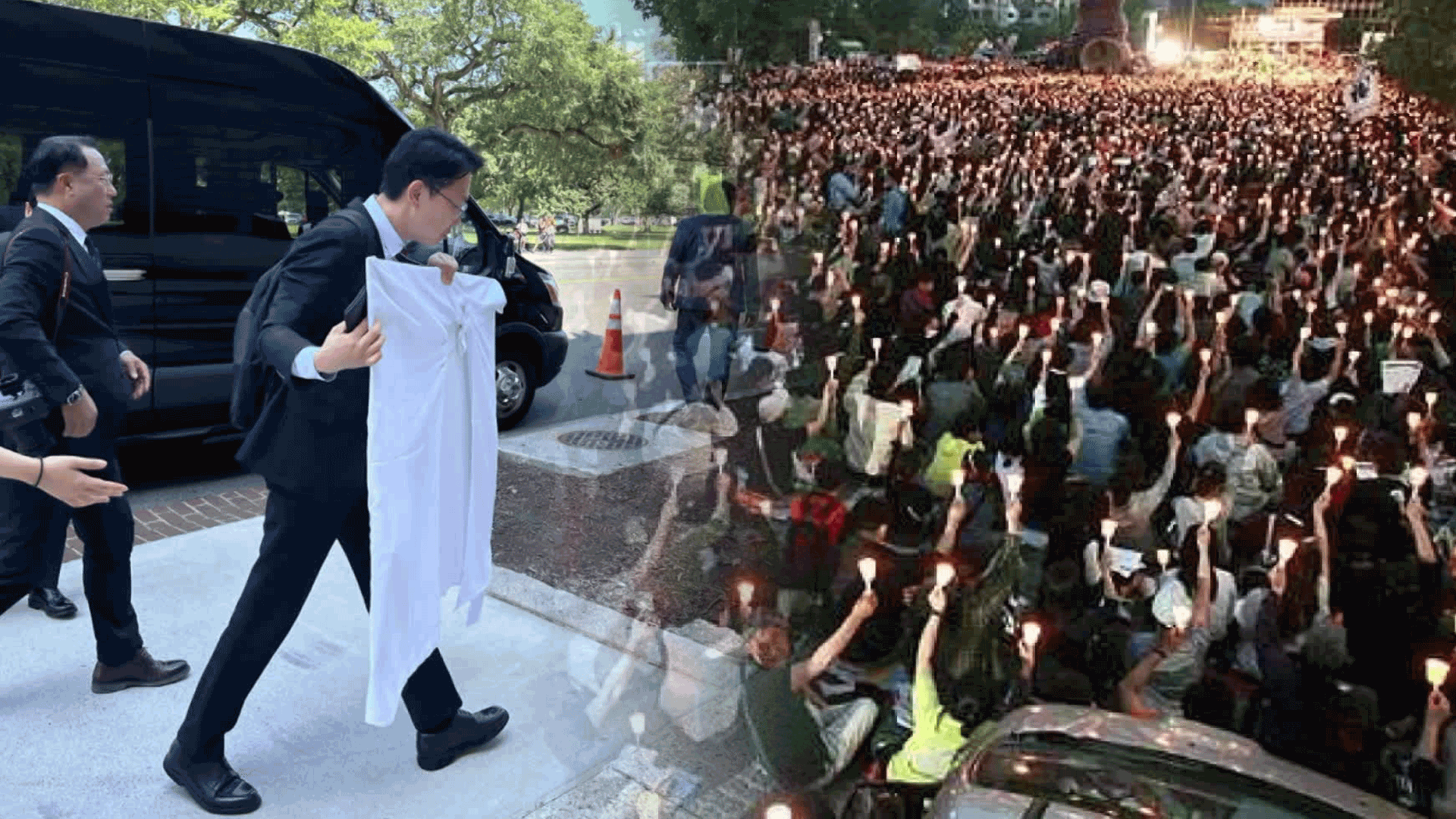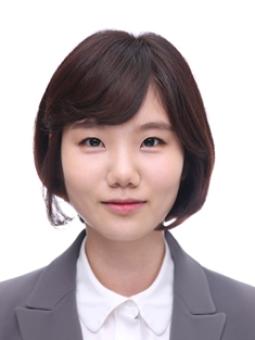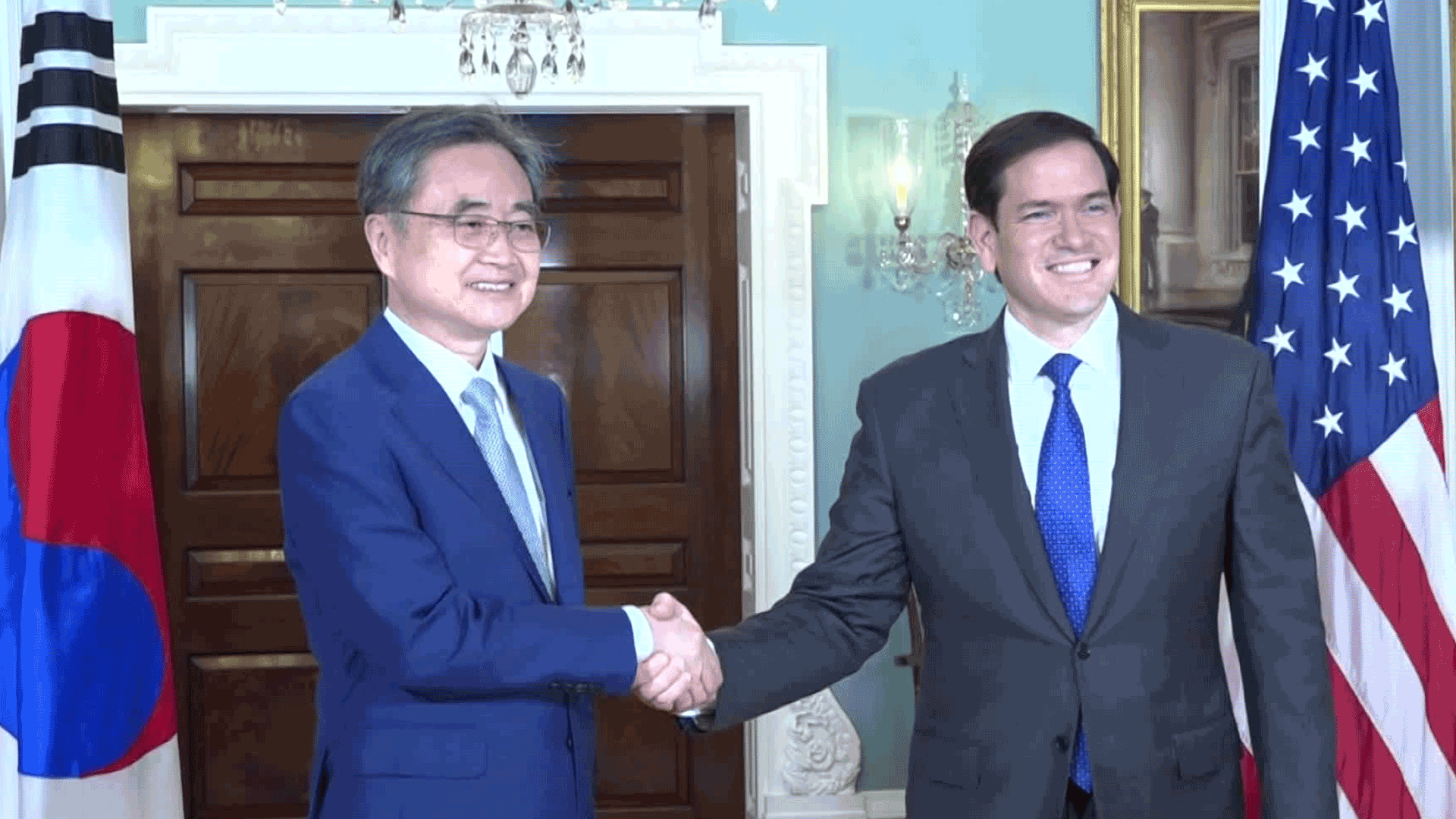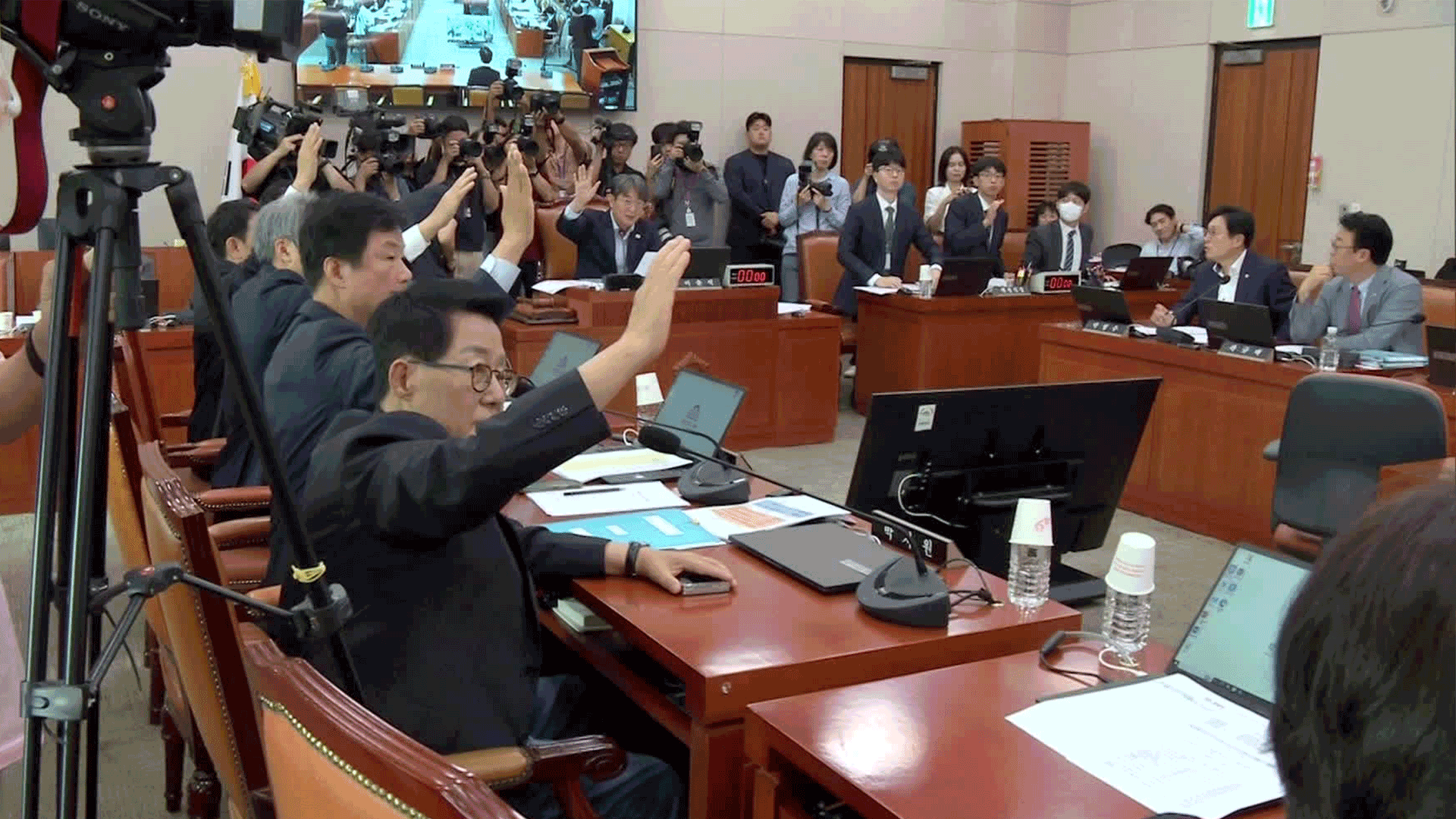Behind the deal making
입력 2025.07.31 (23:56)
수정 2025.08.01 (04:42)
읽어주기 기능은 크롬기반의
브라우저에서만 사용하실 수 있습니다.
[Anchor]
In early April, President Trump specifically referred to South Korea as the 'worst'.
[Donald Trump/President of the United States: "Worst of all are the non-mometary retrictions imposed by South Korea, Japan and very many other nations as a result of these colossal trade barriers."]
He then declared that he would impose a 25% reciprocal tariff, higher than that of the European Union or Japan.
This was a massive external shock to our country, which was experiencing political turmoil.
Two days later, the president was impeached, and the negotiations led by the former government's economic chief, who had no real decision-making power, yielded little success.
Even after the launch of the Lee Jae Myung government, the U.S. unilateral approach continued.
With a letter stating that a 25% tariff would be imposed starting August 1, the sense of crisis heightened.
In fact, we had less than a month to respond properly.
In a last-ditch effort, we overcame the final hurdle just a day before the deadline.
In the tense negotiations behind the scenes, reporter Kim Chae-rin reports.
[Report]
A white cloth-wrapped item held by the negotiating team entering the U.S. Department of Commerce building.
It is a specially made signboard measuring 1 meter in length and width.
It summarizes the benefits that both South Korea and the U.S. can enjoy from projects like 'MASGA' and the Korea-U.S. cooperation project.
This signboard was presented at the first meeting and was highly praised by Secretary of Commerce Lutnick.
The next day, the location was moved to Secretary Lutnick's residence in New York, where the Korea-U.S. teams contributed ideas.
After that, the team followed up to Scotland, meeting two more times, and this signboard played a crucial role until the negotiations made significant progress.
[Howard Lutnick/U.S. Secretary of Commerce/28th/Fox News Interview: "The South Koreans flew to Scotland to meet with me and Ambassador Greer after dinner. I mean, think about how much they really wanted to get a deal done. "]
The final negotiations, which had been a tug-of-war, then took a tense turn.
On the 30th local time, following the '3+2 negotiations', a phone call came in, and the negotiating team headed to the White House, where news of the agreement was delivered about two hours after meeting with Trump.
The hidden card that blocked the U.S. side's fierce demands for agricultural product openings was 'photos'.
Crowds gathered in 2008, shouting against the resumption of U.S. beef imports.
Holding vivid photos of angry protesters and children with candles, they continuously showed them to the U.S. negotiating representatives.
This was a persuasive strategy that emotionally appealed to the sensitivity of the issue.
The large signboard and photos were crucial scenes hidden behind the negotiation's success.
This is KBS News, Kim Chae-rin.
In early April, President Trump specifically referred to South Korea as the 'worst'.
[Donald Trump/President of the United States: "Worst of all are the non-mometary retrictions imposed by South Korea, Japan and very many other nations as a result of these colossal trade barriers."]
He then declared that he would impose a 25% reciprocal tariff, higher than that of the European Union or Japan.
This was a massive external shock to our country, which was experiencing political turmoil.
Two days later, the president was impeached, and the negotiations led by the former government's economic chief, who had no real decision-making power, yielded little success.
Even after the launch of the Lee Jae Myung government, the U.S. unilateral approach continued.
With a letter stating that a 25% tariff would be imposed starting August 1, the sense of crisis heightened.
In fact, we had less than a month to respond properly.
In a last-ditch effort, we overcame the final hurdle just a day before the deadline.
In the tense negotiations behind the scenes, reporter Kim Chae-rin reports.
[Report]
A white cloth-wrapped item held by the negotiating team entering the U.S. Department of Commerce building.
It is a specially made signboard measuring 1 meter in length and width.
It summarizes the benefits that both South Korea and the U.S. can enjoy from projects like 'MASGA' and the Korea-U.S. cooperation project.
This signboard was presented at the first meeting and was highly praised by Secretary of Commerce Lutnick.
The next day, the location was moved to Secretary Lutnick's residence in New York, where the Korea-U.S. teams contributed ideas.
After that, the team followed up to Scotland, meeting two more times, and this signboard played a crucial role until the negotiations made significant progress.
[Howard Lutnick/U.S. Secretary of Commerce/28th/Fox News Interview: "The South Koreans flew to Scotland to meet with me and Ambassador Greer after dinner. I mean, think about how much they really wanted to get a deal done. "]
The final negotiations, which had been a tug-of-war, then took a tense turn.
On the 30th local time, following the '3+2 negotiations', a phone call came in, and the negotiating team headed to the White House, where news of the agreement was delivered about two hours after meeting with Trump.
The hidden card that blocked the U.S. side's fierce demands for agricultural product openings was 'photos'.
Crowds gathered in 2008, shouting against the resumption of U.S. beef imports.
Holding vivid photos of angry protesters and children with candles, they continuously showed them to the U.S. negotiating representatives.
This was a persuasive strategy that emotionally appealed to the sensitivity of the issue.
The large signboard and photos were crucial scenes hidden behind the negotiation's success.
This is KBS News, Kim Chae-rin.
■ 제보하기
▷ 카카오톡 : 'KBS제보' 검색, 채널 추가
▷ 전화 : 02-781-1234, 4444
▷ 이메일 : kbs1234@kbs.co.kr
▷ 유튜브, 네이버, 카카오에서도 KBS뉴스를 구독해주세요!
- Behind the deal making
-
- 입력 2025-07-31 23:56:50
- 수정2025-08-01 04:42:32

[Anchor]
In early April, President Trump specifically referred to South Korea as the 'worst'.
[Donald Trump/President of the United States: "Worst of all are the non-mometary retrictions imposed by South Korea, Japan and very many other nations as a result of these colossal trade barriers."]
He then declared that he would impose a 25% reciprocal tariff, higher than that of the European Union or Japan.
This was a massive external shock to our country, which was experiencing political turmoil.
Two days later, the president was impeached, and the negotiations led by the former government's economic chief, who had no real decision-making power, yielded little success.
Even after the launch of the Lee Jae Myung government, the U.S. unilateral approach continued.
With a letter stating that a 25% tariff would be imposed starting August 1, the sense of crisis heightened.
In fact, we had less than a month to respond properly.
In a last-ditch effort, we overcame the final hurdle just a day before the deadline.
In the tense negotiations behind the scenes, reporter Kim Chae-rin reports.
[Report]
A white cloth-wrapped item held by the negotiating team entering the U.S. Department of Commerce building.
It is a specially made signboard measuring 1 meter in length and width.
It summarizes the benefits that both South Korea and the U.S. can enjoy from projects like 'MASGA' and the Korea-U.S. cooperation project.
This signboard was presented at the first meeting and was highly praised by Secretary of Commerce Lutnick.
The next day, the location was moved to Secretary Lutnick's residence in New York, where the Korea-U.S. teams contributed ideas.
After that, the team followed up to Scotland, meeting two more times, and this signboard played a crucial role until the negotiations made significant progress.
[Howard Lutnick/U.S. Secretary of Commerce/28th/Fox News Interview: "The South Koreans flew to Scotland to meet with me and Ambassador Greer after dinner. I mean, think about how much they really wanted to get a deal done. "]
The final negotiations, which had been a tug-of-war, then took a tense turn.
On the 30th local time, following the '3+2 negotiations', a phone call came in, and the negotiating team headed to the White House, where news of the agreement was delivered about two hours after meeting with Trump.
The hidden card that blocked the U.S. side's fierce demands for agricultural product openings was 'photos'.
Crowds gathered in 2008, shouting against the resumption of U.S. beef imports.
Holding vivid photos of angry protesters and children with candles, they continuously showed them to the U.S. negotiating representatives.
This was a persuasive strategy that emotionally appealed to the sensitivity of the issue.
The large signboard and photos were crucial scenes hidden behind the negotiation's success.
This is KBS News, Kim Chae-rin.
In early April, President Trump specifically referred to South Korea as the 'worst'.
[Donald Trump/President of the United States: "Worst of all are the non-mometary retrictions imposed by South Korea, Japan and very many other nations as a result of these colossal trade barriers."]
He then declared that he would impose a 25% reciprocal tariff, higher than that of the European Union or Japan.
This was a massive external shock to our country, which was experiencing political turmoil.
Two days later, the president was impeached, and the negotiations led by the former government's economic chief, who had no real decision-making power, yielded little success.
Even after the launch of the Lee Jae Myung government, the U.S. unilateral approach continued.
With a letter stating that a 25% tariff would be imposed starting August 1, the sense of crisis heightened.
In fact, we had less than a month to respond properly.
In a last-ditch effort, we overcame the final hurdle just a day before the deadline.
In the tense negotiations behind the scenes, reporter Kim Chae-rin reports.
[Report]
A white cloth-wrapped item held by the negotiating team entering the U.S. Department of Commerce building.
It is a specially made signboard measuring 1 meter in length and width.
It summarizes the benefits that both South Korea and the U.S. can enjoy from projects like 'MASGA' and the Korea-U.S. cooperation project.
This signboard was presented at the first meeting and was highly praised by Secretary of Commerce Lutnick.
The next day, the location was moved to Secretary Lutnick's residence in New York, where the Korea-U.S. teams contributed ideas.
After that, the team followed up to Scotland, meeting two more times, and this signboard played a crucial role until the negotiations made significant progress.
[Howard Lutnick/U.S. Secretary of Commerce/28th/Fox News Interview: "The South Koreans flew to Scotland to meet with me and Ambassador Greer after dinner. I mean, think about how much they really wanted to get a deal done. "]
The final negotiations, which had been a tug-of-war, then took a tense turn.
On the 30th local time, following the '3+2 negotiations', a phone call came in, and the negotiating team headed to the White House, where news of the agreement was delivered about two hours after meeting with Trump.
The hidden card that blocked the U.S. side's fierce demands for agricultural product openings was 'photos'.
Crowds gathered in 2008, shouting against the resumption of U.S. beef imports.
Holding vivid photos of angry protesters and children with candles, they continuously showed them to the U.S. negotiating representatives.
This was a persuasive strategy that emotionally appealed to the sensitivity of the issue.
The large signboard and photos were crucial scenes hidden behind the negotiation's success.
This is KBS News, Kim Chae-rin.
-
-

김귀수 기자 seowoo10@kbs.co.kr
김귀수 기자의 기사 모음 -

김채린 기자 dig@kbs.co.kr
김채린 기자의 기사 모음
-
이 기사가 좋으셨다면
-
좋아요
0
-
응원해요
0
-
후속 원해요
0















이 기사에 대한 의견을 남겨주세요.